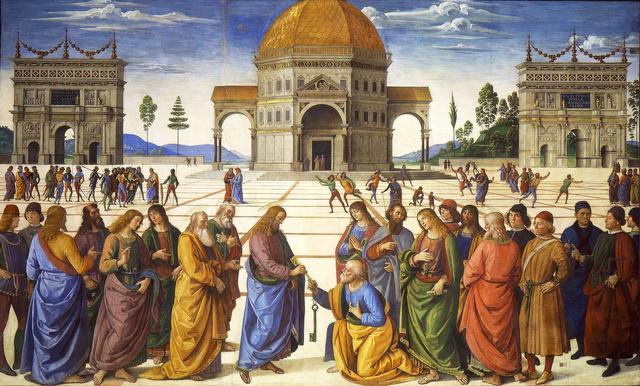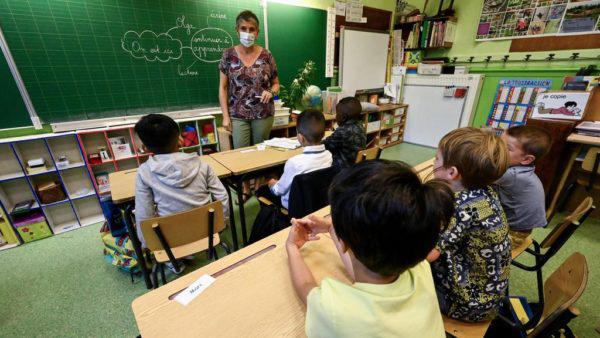
The conception of truth is often taken between relativism and constructivism.Should we then give in to subjective perspectivism or can we build shared perspectives?
All the speeches on our time are tense between dimensions that have become problematic.Some still summon "the" truth, others give in to the facts which seem given to them, the third reduce the facts to interpretations, the others still denied the possibility of a truth, and the last dissolve the interpretations in a separate perspectivism.What should we hear by "perspectivism"?It is to explain this notion that this work of Emmanuel Alloa, professor of aesthetics and art philosophy at the University of Friborg, is attached, taking into account the different uses of the idea of perspective in thecurrent language and in that of art history.
The thesis defended has as its starting point the development of the concept of perspective in painting, without resolving in art.It is as follows: it would be wrong to see in the discovery of the central perspective, during the Quattrocento, an awareness of the irreconcilable plurality of the points of view.On the contrary, the perspective system aims to unify spaces that remained separated until then, like divine space and human space that the Byzantine art of icons takes so much care to distinguish.With him the point of view merges with the flight point.
If we can establish this, it is also that there is something shared and shareable in perspective and "point of view".The fact remains that a question remains central: can the perspective be or become a common?And very largely: common to all, to all cultures, to all eras?Or is it the result of a social agreement, giving rise to the most varied representations in the world?The question, it is true, does not concern those who have worked to establish the laws of perspective.But from the moment we think about the relationship between the perception of the visible world and its representation, then the question becomes decisive.
The notion of perspective
The terms of the debate, "perspective" and "point of view", present themselves in beautiful polysemy, many of which take little into account.So they miss the essentials.And in particular the reason why being interested in these notions.Because the era pushes us to also question the familiar expression that results from these words?But does not the notion of "particular opinion" (particular, particularism, subjectivism) hide an intellectual terrorism, not without also supporting the proliferation of false information (Fake News), which is a phenomenon that touchesAt perspective?The contempt for the true is accustomed to the rhetoric perspectivist, since it evokes, rightly or wrongly, an irreducible diversity of points of view.That said, it is indeed at the cost of considering society as a set of islets between which nothing circulates.And dissolution in this sense of all "common" makes it possible to strengthen the deployment of the era of post-truth.
Also, conversely, in many, perspectivism has bad press.And if we showed that, no doubt, but in a sneaky way, the perspective argument was diverted by force that do not care about emancipatory ideals?Which amounts to wondering how the perspective now goes for an individualism, in the sense that if there is perspective, there can no longer exist omniscient knowledge or knowledge sharing.
That being that, Blaise Pascal has seen a problem with a problem that really looks like that that Alloa wants to deal with: the perspective in painting tells us how to see a painting but when we are doing towards morality and truth, which tells us whereThe right point of view?

The perspective in painting
What to do, first of all, perspective as a pictorial technique, in linear or air perspective in particular?What to do also with the way in which literature accommodates different ways of making "points of view" appear, either by separating them, either by adding them or by excluding them, but trying to reach a complete rendering of theworld ?
Superreptitiously, this question amounts to wondering why this term, "perspective", was adopted.Perspective is a word that comes from the Latin per-spicere, verb with a transitive appearance, meaning "see by", "see through", in any case "see something" for someone and not everything.The perspective involves selection (which is well underlined by Albrecht Dürer).This is the term used by the philosopher boèce to translate the optical art of the Greeks.
By means of what, we must go back to the question: can we not think of a Communis perspective, a common perspective (not because supported in common, but because belonging to all)?What role did the variable of the perspective play in the constitution of a shared intersubjective space?Finally, to what extent is the perspective common?Who can have it sharing it?How is it a vector of gathering but also of division and separation?What can a perspective regime be arranged so that we are moving towards future projects?
A perspective vision
Alloa's work continues in the form of an exploration trying to grasp the way in which the central perspective has been favored.Especially since it is not the only perspective representation.A decentering of the gaze, beyond the Western context, makes it possible to confirm it.Admittedly, it was needed during the rebirth to invoke a principle of legitimate construction, but the simple fact of determining it well presupposes the existence of other possibilities.Besides, painters never resolve to submit to it without fail.They move, re -examine this legitimate perspective.These are in particular the displacement games found at Piero Della Franscesca and Holbein.
Therefore a human view in perspective is never natural.Chilling the Albertian pictorial space convention is even a will.Mannerism and the baroque love hidden, ambivalent figures, facing which the viewer discovers that one image can hide another.What we find in the parallel perspective of Abraham Bosse.Unlike the focal or conical perspective, centered on the spectator's eye, the parallel perspectives make it possible to preserve the proportions of the objects, their angles, and the consistency that is specific to them.The extreme point by being the axonometric perspective.
But this investigation is ready for other considerations.Finally, figuration is no longer explained by vision, but vision by figuration.Classic paint generates a process of iconization of sight.Alloa reports on philosophical discussions on the perspective nature of vision.Natural vision from 1600 is explained in terms of pictorial representation, as in an artialization of nature.The eye is now described as an obscura camera in which the pupil occupies the function of shutter.And the retina acts as a projection surface on which the inverted image of the outside show is printed.
Perspective and spectator
From the perspective, the spectator has become any spectator, substitutable and anonymous.Although he has to bring his body to see in his eyes.It allows everyone to access the judge's position.The invitation made by Brunelleschi to spectators to come and put himself in the place of the inventor, implies to situate himself on the same plane as this.
What is played out in the artistic experience of the perspective is on two levels.On the level built by the artist in order to play the relationship between image and reality;In terms of the spectator, called to enhance a horizontal situation.The representative perspective becomes an inaugural moment of a standard and does not remain a simple pictorial technique.This standard defines the artistic horizon in which the image must only make one with what the spectator sees.This is how the spectator sets himself.The perspective in question calls for a motionless spectator.In this optical device the fixed point is both the prerequisite and the result.The eye is reduced to a point.And this point determines the escape point which establishes the place of the spectator.As Hubert Damisch indicates, there is nothing less "than the position of the subject, the emergence of a science and the status of representation" (the origin of the perspective, 1987).And it would be wrong to see in the discovery of the central perspective, during the Quattrocento, an awareness of the irreconcilable plurality of the points of view.The perspective device, on the contrary, to unify spaces that remained separated until then, like divine space and human space that Byzantine art separated.
Perspective and perspective
If we closely follow the proposed development, we quickly perceive that the author wants to insist, among other things, on which the perspective does not exclude the relationship to the other, and moreover, the whole conclusion ofThe work is doomed to consolidate this idea, especially in the face of an era of doubt, sometimes, of cynicism, often.It is then about perspective as well as literature: it is a privileged device to force the subject to adopt the point of view of others.We understand that these reflections engage considerations on democracy, around which the author published the analyzes of Nicolas Machiavelli, or Michel de Montaigne, even Immanuel Kant (and his maxim of enlarged thought).
Contrary to what we believe in this regard, Friedrich Nietzsche has not fallen into the trap of a perspective identified with an interminable diffraction.And if, indeed, the perspective made possible a convergence of all eyes towards a central point.It would then play a role in the constitution of a common practical world with sharing of perspectives.She would push everyone to worry about other points of view, she would invite to move to consider the world from another point of view, and accept that everything that appears is visible by all.
In any case, the intelligence of such a reflection is based on the fact that the world is complex and that a reference to an absolute risk of simplifying it.Thus goes the precise and very relevant consideration of the work of Erwin Panofsky by Alloa.Panofsky wonders if perspective is a symbolic form.Is there something like a natural perspective in general, or is it only perspectives that are always singular, circumscribed and dependent on their socio-cultural contexts?The thing is not heard immediately.Panofsky also aims to denounce the central perspective as an artificial construction and to rehabilitate the spheroidal perspective, allegedly closer to natural perception, in favor of the curved perspective called "natural perception".Does our retina be curved means that the perception of space is too?Naturalism or constructivism?How can space be thought of?For antiquity, the conception of space would be relational.From the Renaissance, it is a homogeneous and unified space that is valued.But this coincidence between the conception of the world and its representation does not complete the history of the perspective.
Opening of perspective
Many relevant pages should be analyzed, punctuating this volume.It has research showing that perspective is never one, it is immediately available in the plural.Which allows the author to conduct a contemporary reflection on the plurality of points of view which feeds on past genealogies and gives them another depth of field.Note also beautiful passages on Plato and his relationship to works of art of his time.Plato, indeed, defends Egyptian art, which according to him the essence of things and not their superficial appearance.But this defense targets the criticism of new artists in Greece.And the adventure of the Phidias Athena deemed to be ugly because there was a sculpture to see in contra-angled.What is the right "point of view"?
Another detour deserves that we stop there.This is Robert Smithson's work, the artist who works in nature.What other reading of his work can therefore be undertaken, while it is too often related to a return to a primordial and inhuman nature, allowing to leave civilization.Smithson would not seek to settle in a landscape that would extend as far as the eye can see, it rather perfected devices which make it possible to reach a kind of view at a loss or a view that goes to its loss.It does not play urban-natural polarity, but a polarity that is played within the vision, between a focal view and a peripheral view.It produces a look that is not reduced to frame the image, but is built as the body progresses in the open space.
In a word, we celebrated, not without reason, the importance that there is to know a position, but beyond this ability to take a stand, there is that of knowing how to get rid of his own.So it is appropriate to return to the question posed by Alloa: is the perspective common?Common to all, to all cultures, to all eras?Or is it the result of a social agreement, giving rise to the most varied representations in the world?







